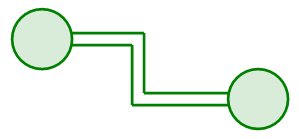 |
|
||
|
I. CHECK PLOT
Check plot is available only for pen plotters because is a low quality plotting of PCB items, being a verification plotting without presenting the real shape of the PCB items. It is used just for plotting outlines (for pads and vias) and centerlines (for tracks). II. ARTWORK Artwork performs high quality plotting for technical documentation and manufacturing. It realizes a positive plotting of all PCB items with any shape and dimensions exactly the same as the job done by the designer during the design stage. The width of traces, non-electrical lines, copper areas and all the settings on the frame of the plot are taken from the settings tables and will be created with high precision in order to create a real board similar to the real one.
Figure Trace with correct width, pads with correct diameter and drill Copper areas There are two types of plotting for copper areas: 1. Filled areas; 2. Hatched areas. There is also another type of plotting used only for documentation with only an outline contour and an empty inside area.
Figure Types of plotting for cooper areas (filled, hatched (meshed), and outline. Solder Mask (Solder Resist) Solder mask (SM) is used for protection of the printed circuit board against electrical, mechanical and climatic factors during its life. It is usually a polymer mask of green colour (rarely light red or blue), with a glass aspect, which is disposed all over the board except pads and via.
The main reason of solder mask disposal is to protect the board for the soldering process of electronic components (in order to have no solder alloy bridges between pads non-connected electrically). After manufacturing of the electronic product, the solder mask won’t be removed and will act as a general protection of the board.
|
 Schematic design of PCB projects
Schematic design of PCB projects 

